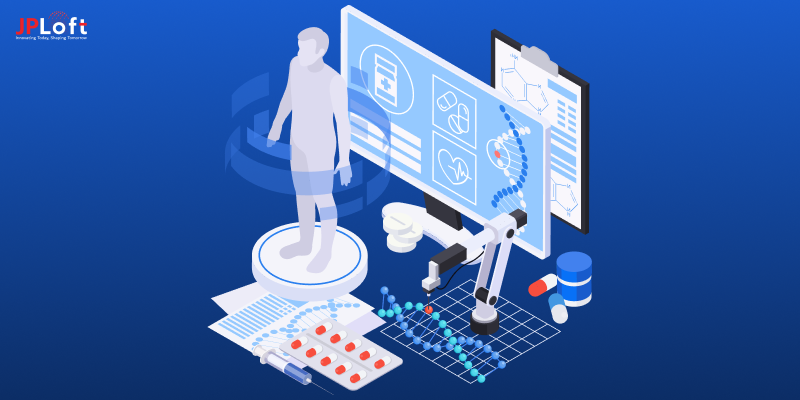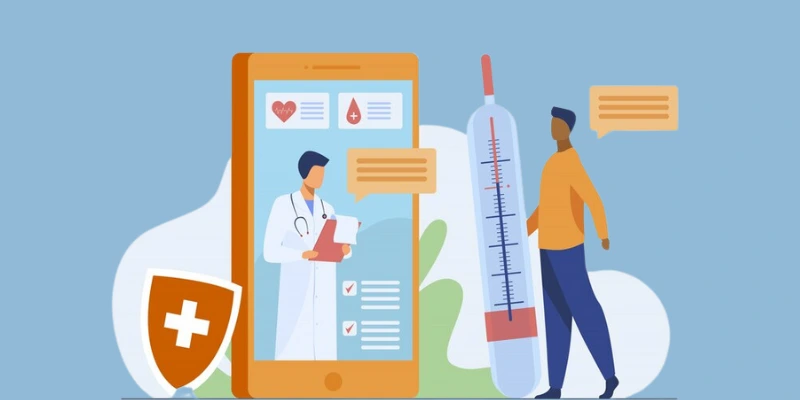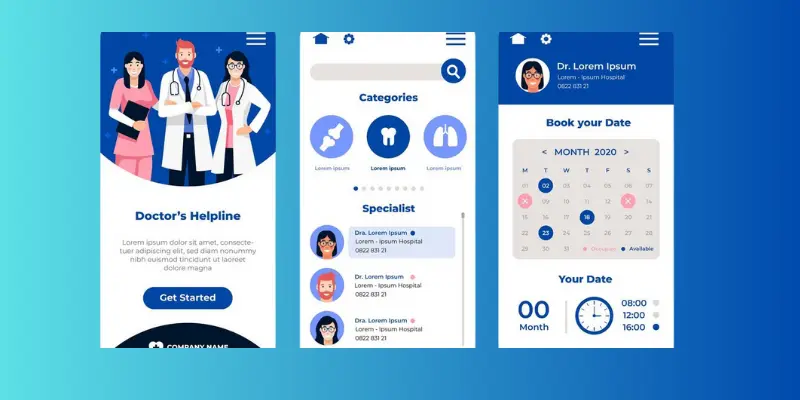Do you want to create a period-tracking app? You are on the right blog.
Imagine helping people better understand their bodies and take control of their health with just a few taps.
If you're considering developing a period-tracking app, you're stepping into a space with huge potential to make a real difference.
It’s not just about counting days- it's about offering users a way to connect with their health in a meaningful, personal way.
This Period tracking app development guide is your one-step solution to know it all. Let’s focus on how you can get started on this exciting journey.
Understanding the Period Tracking App- A Quick Overview
So, what exactly is a “Period Tracking App?”
A period-tracking app is a digital tool designed to help users monitor and manage their menstrual cycles.
By tracking periods, symptoms, moods, and even fertility windows, these apps provide valuable insights into one’s reproductive health.
They not only help users predict when their next period will start but also offer reminders for birth control, doctor appointments, or important health checks.
Most period-tracking apps allow users to input data like cycle length, flow intensity, and physical or emotional symptoms, which the app then analyzes to predict future cycles.
Some apps even offer additional features like fertility tracking for those trying to conceive or tracking other health conditions linked to the menstrual cycle.
These apps have become essential tools for anyone looking to take charge of their health in a simple, efficient way.
Whether you're tracking health, convenience, or family planning, period-tracking apps offer practical, personalized support.
Period Tracking App Market Stats
Period tracking apps are growing in number. Here are some of the key stats that show the evolving trend:
-
Market Size and Growth: In 2022, the global menstrual health apps market was valued at approximately USD 1.2 billion. Projections suggest a compound annual growth rate (CAGR) of around 19.9% from 2023 to 2030, potentially reaching USD 5.1 billion by 2030.
-
Regional Insights: North America led the market, attributed to factors like high digital literacy and widespread smartphone usage. The Asia-Pacific region is anticipated to experience the fastest growth during the forecast period.
-
User Adoption: A study covering 112 countries found that three apps—Clue, Flo, and Period Tracker- dominated the market, collectively surpassing 250 million downloads. While most downloads were in the Global North, there was notable usage in the Global South, especially in South America.
-
Revenue Leaders: In July 2024, Flo led global revenues among period tracking apps with approximately USD 8.8 million, followed by Natural Cycles with about USD 950,000, and Clue Period Tracker with around USD 600,000.
These stats underscore the growing importance and profitability of period-tracking apps in the digital health landscape, driven by increasing health awareness.
If you create an app in this niche, there is a vast potential for growth and success.
Why Should You Build a Period Tracking App?
Is it worth it to create a period-tracking app right now? The short answer: Yes!
But let’s dive into why we’re so confident about that. Here are some exciting reasons why it is a great idea to develop a period-tracking app.
See below, why it is a huge idea:
A] Growing Market Demand
The global menstrual health app market is booming. It is expected to reach USD 5.1 billion by 2030.
With more people looking for ways to track their cycles and manage their health, now is a prime time to develop a period-tracking app and tap into this rapidly expanding market.
B] A Rising Focus on Women’s Health
Women’s health, including menstrual health, is receiving more attention than ever. Nearly 80% of women in the U.S. use digital tools to track their menstrual cycles.
By developing a period-tracking app, you're catering to a growing audience that values convenience and personalized health management.
C] Opportunity for Personalization and Engagement
Users expect apps to cater to their unique needs. Period tracking apps like Flo and Clue allow for tracking personalized symptoms, moods, and cycles, offering a tailored experience.
These apps collectively have over 250 million downloads, with personalized features driving user loyalty and engagement.
If you create a period tracking app that offers these customized features, you can stand out in the market and keep users engaged long-term.
D] Monetization Potential
The period tracking app market isn’t just big; it’s also lucrative. Flo, one of the leading apps, generated approximately USD 8.8 million in revenue in July 2024 alone.
Monetization options include premium features, in-app purchases, or ads, making it a viable opportunity to turn your app into a profitable venture.
These points clearly show that there’s a huge demand, and a growing focus on health, especially in the women’s sector, is what is driving the demand.
How to Create a Period Tracking App: A Step-By-Step Guide
So, “ How to develop a period tracking app?” This is one of the common questions someone who is interested in this industry has.
Now, coming to that, this is where we are going to share a step-by-step guide to period-tracking app development.
Step 1: Research & Define Your Goal
Before jumping into the development process, take some time to research the market.
Who is your target audience? What features do they need? What are your competitors offering, and how can you stand out?
Start by asking yourself:
-
What’s the core problem your app will solve?
-
What features will make your app unique?
-
How will users benefit from using your app regularly?
Defining your goals early will shape the entire period tracking app development process.
Step 2: Plan Essential Features
When you’re figuring out how to create a period-tracking app, one of the first things to consider is the features you want to offer. Some of the basics include:
-
Cycle Tracking: Predict upcoming periods and fertile windows.
-
Symptom Logging: Track physical and emotional symptoms.
-
Reminders: Alerts for medication or doctor appointments.
-
Health Insights: Visual data on patterns and cycle trends.
Don’t forget that the simpler and more intuitive your app is, the better the user experience will be.
Step 3: Design the User Interface (UI) & User Experience (UX)
Creating a clean, easy-to-use UI/UX Design is key. Users should feel comfortable navigating through your app. For period-tracking app development, simplicity is everything.
An app wireframe helps visualize the structure and flow of your app, while an app prototype demonstrates its functionality and user interaction before development begins.
Here’s what to focus on:
-
Easy navigation: Make sure users can input data quickly without a lot of steps.
-
Visually appealing: Use colors and designs that resonate with your audience.
-
User-friendly features: Simple graphs, clear data, and friendly icons.
User experience matters a lot! The smoother it is, the more likely users will stick with your app.
Step 4: Choose the Right Development Platform
Now, it's time to choose the platform.
Will you develop a web app, go for Android app development or iOS app development, or all three?
-
Native apps (iOS/Android) are ideal for the best performance.
-
Cross-platform development (like React Native) allows you to reach a larger audience.
Whichever path you choose, ensure it’s compatible with your target users' devices and preferences.
Step 5: Development & Coding
Once you’ve nailed down the design, it’s time for the actual development phase. If you’re not a developer yourself, you’ll need to hire mobile app developers or collaborate with a skilled development team.
For period tracking app development, ensure the following:
-
Data storage: Securely store users' personal and health data.
-
Calendar functionality: Accurately predict cycles based on user input.
-
Privacy: Given the sensitive nature of menstrual data, strong encryption is needed for data privacy and app security.
Step 6: Test Your App
App testing is a crucial step in how to build a period tracking app.
Once your app is built, test it across different devices and operating systems. Get feedback from real users to ensure it’s working properly.
Make sure to:
-
Test the accuracy of the period predictions.
-
Ensure that reminders and notifications work smoothly.
-
Check for bugs or glitches in the design and functionality.
Step 7: Launch & Market Your App
Now that you’ve completed your guide to period tracking app development, it’s time to launch!
You can submit your app on the App Store or publish it on the play store. But before you go live, think about how you’ll market your app. You need a strategy to attract users and keep them engaged.
Here’s how to get started:
-
App Store Optimization (ASO): Optimize your app’s description and keywords to help users find it.
-
Social media: Use platforms like Instagram or TikTok to create awareness.
-
Content marketing: Offer blog posts, tips, and resources related to menstrual health to build a loyal user base.
Step 8: Maintain & Update Regularly
Once your app is live, app maintenance services are an essential part of how to develop a period tracking app.
Regular updates are necessary to fix bugs, introduce new features, and respond to user feedback.
By consistently improving your app’s functionality and adding fresh content, you keep users engaged and ensure it remains relevant. This ongoing effort builds trust and strengthens user loyalty over time.
These are some of the steps you have to go through to build your own period tracking app, but there is more to it, such as features. This is what we are going to understand in the next step.
Essential Period Tracking App Features
When you’re looking to create a period tracking app, the features you choose are crucial to making the app useful and appealing.
The goal is to provide value to users by helping them track and understand their menstrual cycles in a simple, efficient way.
Let’s take a look at some of the must-have features for your period-tracking app development.
|
Feature |
Description |
|
Cycle Prediction |
Predict upcoming periods, fertile windows, and ovulation days based on past data. |
|
Symptom Tracker |
Log physical and emotional symptoms like cramps, mood swings, and headaches. |
|
Reminders & Notifications |
Send alerts for period start dates, birth control, or upcoming doctor appointments. |
|
Health Insights & Analytics |
Offer users visual data on their cycle trends, average cycle length, and symptom patterns. |
|
Mood Tracker |
It allows users to track their mood fluctuations and emotional changes during their cycle. |
|
Personalized Cycle Data |
Let users customize their cycle input, including irregular cycles or PCOS tracking. |
|
Privacy & Security |
Ensure robust encryption to protect sensitive health data and comply with privacy regulations. |
|
Community & Support |
Create a platform where users can access helpful articles, FAQs, or community groups for support. |
These features not only improve the overall user experience but also help users feel more connected to their health data.
Whether they’re tracking their cycle for fertility or just staying aware of their health, the right features will make your period-tracking app a go-to tool.
Who Should Build a Period Tracking App?
If you’re thinking about venturing into the world of period-tracking apps, you might be wondering, Who should create a period-tracking app?
Well, the answer is that this opportunity isn’t just for tech experts. Many different people, from health professionals to entrepreneurs, can benefit from building such an app.
If you’ve got a passion for health tech and want to help others improve their wellness, this could be the perfect project for you.
So, who exactly should develop a period-tracking app? Let’s break it down:
► Health and Wellness Enthusiasts
If you’ve always had an interest in women’s health or wellness and want to make a difference, creating a period-tracking app could be your chance to give back.
Your knowledge about cycles, symptoms, and health trends could shape an app that truly empowers users.
► Entrepreneurs with a Passion for Tech
If you’re someone who has an entrepreneurial mindset and a love for technology, there’s no reason you can’t make a period-tracking app.
With the right skills or a team, you can bring your idea to life and build a product that can positively impact people’s health journeys.
► Healthcare Providers and Professionals
Doctors, therapists, or health professionals who are passionate about women’s reproductive health might consider building a period-tracking app as a tool to enhance patient care.
By incorporating medical expertise, they can design an app that’s both medically accurate and easy to use.
► Product Owners in the Health Space
If you're working on a product related to women's health, this could be a fantastic project to tackle.
You already understand how to oversee development from ideation to launch, so why not take on a period-tracking app as your next big challenge?
► Companies in Women’s Health & Wellness
Brands that already serve the health and wellness space- whether it’s through fitness apps, health supplements, or reproductive health- could find building a period tracking app to be a great way to expand their offerings.
You can create a period-tracking app that complements your existing products and strengthens your brand presence.
Building a period tracking app isn’t just for a specific group of people- it’s for anyone passionate about health, technology, and creating products that make a real difference.
If you have the drive and vision, this could be your chance to make an impact.
As we are done with who should develop time to know the cost to develop a period tracking app.
How Much Does it Cost to Develop a Period Tracking App?
On average, the Peroid tracking app development cost can be around $10,000 to $50,000+, depending on your requirements and project complexity.
Much like any other app development cost, there are several elements that affect the overall cost to develop a
Suppose you have an idea that requires just basic features, then the cost might be low, but if you want customized features that increase the complexity of the app, the development time and cost will be higher.
Let’s break it down step by step, from planning to maintenance and updates:
|
Stage |
Estimated Cost Impact |
Description |
|
Planning & Research |
$2,000 - $5,000 |
Time spent researching user needs, defining features, and market analysis. |
|
App Design (UI/UX) |
$5,000 - $15,000 |
Creating wireframes and prototypes and ensuring an intuitive design. |
|
Core Features Development |
$10,000 - $25,000 |
Building essential features like cycle tracking, symptom logging, and reminders. |
|
Advanced Features |
$20,000 - $35,000 |
Adding health insights, mood tracking, predictive analytics, and customization. |
|
Platform Development |
$10,000 - $20,000 per platform |
Developing the app for iOS, Android, or both platforms. |
|
Data Security & Compliance |
$5,000 - $10,000 |
Ensuring your app complies with privacy regulations (GDPR, HIPAA). |
|
Testing & Launch |
$2,000 - $7,000 |
Bug testing, user feedback, and preparing for the launch. |
|
Maintenance & Updates |
$2,000 - $10,000 annually |
Ongoing updates, bug fixes, and adding new features based on user feedback. |
Popular Period Tracking Apps For Inspiration
There are so many period-tracking apps available in the market.
To ensure that you are doing it right, having a clue of what’s already out there in the market can make a huge difference.
Let’s have a brief introduction to the popular period tracking apps:
1. Clue
Clue is one of the most well-known period-tracking apps. It stands out for its scientific approach to cycle tracking.
Clue’s users can track their periods, symptoms, moods, and even sexual activity. It’s a sleek, data-driven app that offers deep insights into your cycle.
For developing a period-tracking app with advanced analytics, Clue is a great inspiration.
2. Flo
Flo offers a beautiful design and an easy-to-use interface. It helps users track their periods, ovulation, and other reproductive health data. What sets Flo apart is its personalized health insights, making it highly user-centric.
If you’re looking to build an app with personalized, data-driven suggestions, Flo is a great reference.
3. Glow
Glow goes beyond period tracking, focusing on fertility and reproductive health. It allows users to track everything from menstruation to pregnancy, with a strong community element for sharing experiences.
In case, you're interested in adding a community aspect or integrating fertility features, Glow provides great inspiration.
4. Ovia
Ovia is a powerhouse when it comes to reproductive health.
With features that track periods, ovulation, fertility, and even pregnancy, Ovia gives users a detailed view of their health. It also uses charts and visual data to help users interpret their cycle.
For anyone looking to expand app functionality into multiple stages of reproductive health, Ovia is a strong model to follow.
5. Period Tracker by GP Apps
This app is all about simplicity. Period Tracker by GP lets users easily log their periods, moods, and symptoms. Its clean and no-frills design makes it perfect for those who prefer simplicity and quick data entry.
If you want to create a period-tracking app that’s minimalist and easy to use, this is a great app to reference.
6. Period Tracker
Period Tracker offers users an easy way to log their periods and symptoms. It gives a straightforward approach to tracking while providing helpful health tips and a calendar to predict future cycles. It’s simple yet effective.
To aim for an easy-to-understand app with a focus on tracking and simplicity, Period Tracker is a great example.
7. My Calendar
My Calendar offers users an easy-to-navigate interface with advanced features like ovulation tracking and customizable symptom tracking. It also includes a password protection feature for added privacy.
For building an app with a focus on privacy and security, My Calendar can offer useful lessons on keeping users' data safe while still providing detailed insights.
8. Ovia
Ovia is designed to be straightforward, helping users track their period cycles and symptoms. It includes basic features like period predictions and symptom logging but keeps things simple for easy use.
If you want to build an app that focuses on simplicity and functionality, this is a great inspiration for keeping things minimal.
Whether you’re looking to develop a period-tracking app with cutting-edge features or something more user-friendly, there’s plenty of inspiration to draw from.
Think about what works well in these apps and how you can improve or add something new to make your app stand out!
Challenges in Developing a Period Tracking App
Transforming your mobile app idea into a successful period tracking platform comes with challenges.
Below we have shared some common obstacles you face while developing a period tracking app along with their solution, so you don't get stuck anywhere.
Challenge 1: Data Privacy and Security
When it comes to period-tracking app development, handling sensitive user data like health information is a challenge. You’ll need to ensure your app complies with data protection regulations (e.g., GDPR, HIPAA).
Solution: Implement strong encryption, user consent forms, and clear privacy policies. Prioritize user security to build trust and ensure compliance.
Challenge 2: Accurate Cycle Prediction
Accurately predicting periods and ovulation can be tricky. Every user’s cycle is unique, so creating an algorithm that works for everyone is a challenge.
Solution: Use machine learning and collect enough data from users to refine predictions. The more data you gather, the more precise your predictions will become in your period-tracking app development process.
Challenge 3: User Engagement
Getting users to engage regularly can be tough. Users might forget to log their data or lose interest over time.
Solution: Send personalized reminders and tips based on their cycle. Incorporate rewards, challenges, and community features to keep users motivated and invested in tracking their health.
Challenge 4: Cross-Platform Compatibility
If you're looking to create a period-tracking app for both Android and iOS, the task of making the app work seamlessly across platforms can be challenging.
Solution: Use a cross-platform development framework like React Native or Flutter to streamline development and ensure a consistent experience across devices.
Challenge 5: Designing a Simple UI/UX
Period tracking apps require complex data, but presenting it in a user-friendly way is a challenge. Too much data can overwhelm users.
Solution: Focus on a clean and intuitive design. Use visual elements like graphs and charts that help users understand their cycle easily. Keep the interface clutter-free.
Challenge 6: Integrating Health Data
Many users may want to sync their period app with other health-tracking devices or apps. This requires complex integrations.
Solution: Offer integrations with popular fitness and health apps like Apple Health and Google Fit. Ensure a smooth data exchange to enhance user experience and functionality.
Challenge 7: Personalization and Customization
Not all users want the same features or experience. Personalization is key, but it can add complexity to app development.
Solution: Allow users to customize their app experience, whether through adjusting tracking preferences, notification settings, or adding personal symptoms. This flexibility will make the app feel tailored to each user.
Extra: Regulatory Compliance To Develop a Period Tracking App
When you set out to develop a period-tracking app, regulatory compliance is something you can’t overlook.
It’s crucial to ensure your app follows legal guidelines, especially because you're handling sensitive health data.
-
GDPR: If you're planning to operate in the EU, you’ll need to follow GDPR guidelines. This includes getting explicit consent from users before collecting their data, being transparent about what data you store, and providing users with the right to delete their data.
-
HIPAA: If your app stores medical data in the U.S., you’ll need to comply with HIPAA. This ensures that user health data is kept private and secure. It applies if your app provides health-related services or communicates with medical professionals.
Although the compliance and laws may change as per the country, these are essential compliances that you need to take care of.
How JPLoft Can Help You to Create a Period Tracking App?
Want to develop a period tracking app? Join hands with a true business partner.
JPLoft is a pioneer in healthcare app development company and has experience in developing and designing successful platforms.
Our successful portfolio depicts many projects that are currently making a name in the market, such as WellTra, which is a standout project.
Partner with JPLoft to bring your period tracking app idea to life with cutting-edge technology and user-centric design.
Let’s connect to bring your dream idea to reality.
Conclusion
In conclusion, embarking on the journey of period tracking app development offers immense potential to tap into the growing demand for personalized health management.
Whether you’re driven by a passion for women’s health, technology, or both, creating a period-tracking app can be a rewarding venture.
With proper planning, research, and an understanding of your target audience, you can build an app that not only addresses users' needs but also stands out in a competitive market.
Keep in mind the importance of data privacy, user engagement, and continuous improvement to ensure long-term success.
FAQs
Both apps are popular, but Clue focuses on scientific tracking, while Flo offers personalized insights. The choice depends on user preference for data-driven vs. personalized experiences.
Research the market, define your features, design the UI/UX, develop core features, ensure privacy and test before launch.
Building a period tracking app typically costs between $10,000 and $50,000+, depending on features, complexity, and platform.
Flo, Clue, and Glow are among the most popular period-tracking apps globally, with millions of downloads.
To create an app like Flo, focus on personalized health insights, seamless UI/UX, robust data privacy, and integration with health data for a tailored user experience.












Share this blog